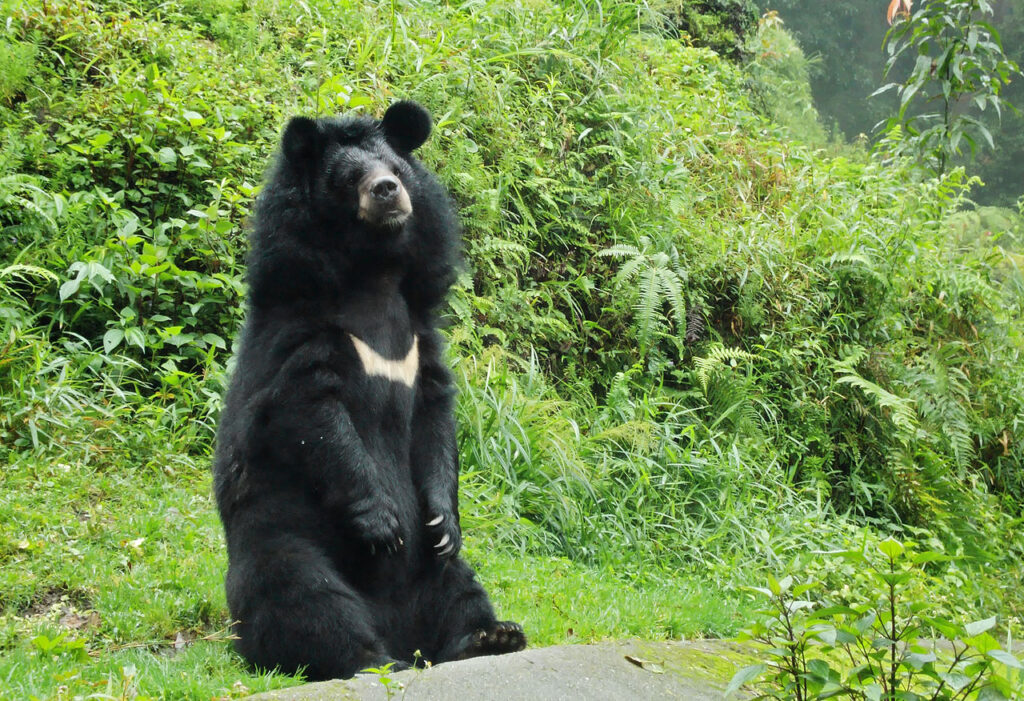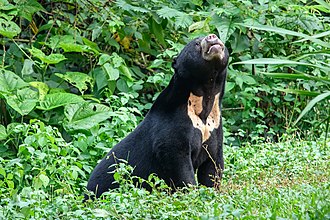Bears, our dear Baloo has always been an important part of the childhood stories, cartoon shows, movies and books. Whenever we hear ‘Baloo’ an image of big jolly bear, always trying to save Mowgli from Sher Khan (Bengal Tiger) comes in our mind, but in reality, a bear is one of the most ferocious wild animals, full of strength. Bear are known for their heavy body, thick & dense fur coat, large canines, lumbering gait and protruding lips, they can be found in forests, mountains, tundra, desert and grassy areas.
There are 8 bear species around the world, from the largest one (Brown Bear) found in Alaska to the smallest one (Sun Bear) found in India. In India we have 4 bear species which are, Himalayan black bear, Sloth bear, Sun bear and Himalayan brown bear. Let’s know about them in details.
Himalayan Black Bears
Himalayan black bear (Ursus thibetanus laniger) is a subspecies of Asiatic black bear found in India. They are known as the Moon bear or White Chased bear as it carries a pale yellow or whitish crescent moon shaped patch on the chest. In India they can be seen in Sikkim, Union territory of Jammu and Kashmir, Assam, Arunachal Pradesh and Himalayan regions ranging from a height of 5000 – 12000 feet and their habitat ranges from coniferous forests to alpine meadows.

Black Bears are large omnivorous animals and their diet comprises of meat and fruits such as barriers, apples, acorns, peaches, maize and honey, they also feed on termites. They weight up to 200 kg (Male) and 100 kg (Female), can grow up to the length of 140-170 cm and has the life span around 25 years.
Himalayan Black Bears are categorized as vulnerable species by IUCN due to their low and continuously declining population. At present there are about only 50,000 bears left in the wild, the reason for this downfall includes habitat loss, climate change, hunting & poaching for their body parts, they have a huge demand in Chinese market as their body parts such as paws, skin, and gall bladders are used in traditional Chinese medicine.
There has been an increase in conflict between these bears and humans, specially during the winters when they come down for crops and small animals like sheep, goats, mules etc.
Himalayan Brown Bears
Himalayan Brown Bear (Ursus Arctos) is the heaviest and biggest among all the four bear species found in India, it is one of the 15 sub species of brown bear, which is reddish brown in color and have a thick fur layer. The males can weigh up to 550 kg and the females can weight up to 250 kg, these beasts can reach an average height of 170 cm.
Himalayan brown bear can be found in Jammu & Kashmir, Himachal Pradesh and in norther Uttarakhand. They are omnivorous and they feed on grasses, peaches, roots, insects and small mammals like marmot, they are known to kill the livestock sheep, goat.
A large part of winter is spent by the brown bears in hibernation, where they lower their heart beats to 10 beats per minute, they usually loose 1/3rd of their weight during the whole hibernation.
Himalayan Brown Bears are categorized as endangered species by IUCN and there are about only 500-700 brown bears left in India due to the poaching, hunting climate, habitat loss etc.
Sun Bears
The Sun Bear (Helarctos malayanus) also known as Honey Bear is one of the rarest bear species which can be found only in north-east India. These bears have a short and sleek fur coat which is usually black and sometimes reddish brown or grey. They weight around 35-70 kg and can reach up to a maximum height of 150 cm. They are the smallest bear species in the world and they have the longest tongue among all the bear species. Their distinctive physical feature makes them easy to be spotted in the wild as they carry a patch on their chest, which is usually orange, yellow or white in color.

Talking about their habitat, these bears can be seen only in the tropical evergreen rainforest, specially in the Barak valley. Sun bears are omnivores, their diet includes honey, bee & beetle larvae, termites, ants, and various kind of fruits.
Sun bears are categorized under vulnerable species and there are about only 1000 of them left in the wild. They are being killed and traded for their body parts and for pets. Other factors like habitat fragmentation, deforestation also adds up to the declining sun bear’s population.
Sloth Bears
Sloth bear (Melursus ursinus) is the India’s most widespread and ubiquitous bear species which can be found in the various geographical range of Western Ghats, Uttar Pradesh, West Bengal, Madhya Pradesh and North-East India.
These bears carry very predominant and unique physical features, they have a long muzzle protruding lip, shaggy hair and V shaped patch on chest. The male can weight up to 145 kg and female weights over 55 kg and can grow up to the length of 170 cm.
Sloth bears are myrmecophagous, which means a major portion of their diet consists of termites and ant, besides that they feed on fruits, honey, tubers etc.
Sloth bears are highly aggressive animals and are considered to be the most dangerous wild animal in India as they are known for attacking humans without any provocation, specially when they are with their cubs. These are the only bear species whose cubs can be seen riding on their mother’s back.
They are listed as vulnerable species due to its hunting and poaching for the body parts, specially gall bladder. There are about only 6000-10000 bears left in India, other factors like habitat fragmentation, human wildlife conflict also adds up to the reasons of its declining population. Wildlife SOS did a wonderful job rescuing India’s Dancing Bears, which mostly consisted of this species.
All these four bear species carry one or another special features but one thing is common among them, they all are facing the human threats which is putting tremendous pressure on their population despite being protected under the Indian Wildlife Protection Act 1972, there is need of stricter laws to eliminate illegal trade and habitats conservation.
Written by Adarsh Singh
Help us Help Them!
Help us Help Them! Think Wildlife Foundation is a non profit organization with various conservation initiatives. Our most prominent campaign is our Caring for Pari intiative. Pari is a rehabilitated elephant at the Wildlife SoS Hospital. 25% of the profits from our store are donated to the elephant hospital for Pari. Other than buying our wonderful merchandise, you could donate directly to our Caring For Pari fundraiser.
